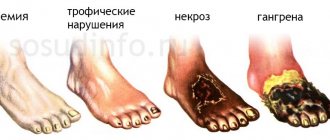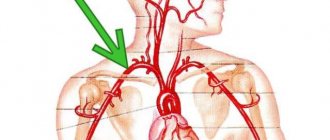Participating in humoral regulation, the heart and adrenal glands are closely related to each other, since the main function of the adrenal glands is the production of hormones. Violation of the proper functioning of this organ negatively affects the entire body. The catecholamine hormones produced have different effects on the functioning of the heart, blood vessels and nervous system. Often the cause of their release into the blood is stress. In other cases, tumors, damage to organ tissue (failure), hyperaldosteronism and other pathologies occur.
What is the cause of paresthesia?
Symptoms can appear in any part of the body, but in most cases they are felt in the arms and legs.
Paresthesia of the limbs can be either temporary or chronic. Symptoms of a temporary problem manifest themselves as follows:
- numbness of the back, limbs;
- weakness;
- tingling in the limbs;
- tingling in the body;
- burning;
- cold;
- pale skin;
- hair loss;
- decrease in temperature.
The chronic form of this condition is often combined with acute pain, which can lead to impaired mobility in the affected limb and cause other concomitant diseases. Therefore, if such persistent symptoms impair the quality of life, you should immediately consult a doctor and begin treatment as quickly as possible.
Signs of the development of paresthesia are:
- tingling;
- crawling sensations;
- numbness;
- burning;
- loss of sensitivity.
These manifestations may be accompanied by additional symptoms: itching, pain, swelling and the appearance of vascular networks. Sometimes at the site of the lesion there is pallor of the skin, thinning of the hairline and a decrease in body temperature.
The pathological process can affect not only the hands, palms and fingers or feet. Numbness and tingling may occur on the lips and tongue, areas of the scalp and face, neck and torso. Sometimes, simultaneously with such disorders, the appearance of trophic ulcers is noted.
With ischemic cerebrovascular accidents, the sensation of numbness and pins and needles occurs suddenly, often affecting only one limb. The attack lasts approximately 10 minutes and is accompanied by paresis or paralysis.
With the development of cardiovascular pathologies, paresthesia manifests itself unexpectedly, and the patient feels cold in the lower extremities. This symptom may be accompanied by partial paralysis.
In thoracic syndrome, it appears when the affected limb is abducted to the side or raised.
With arthritis, numbness in the collar area and arms is more common. With lesions of the lumbar spine, it often appears on the legs and feet. With herniated discs, a sensation of pins and needles and numbness occurs along the pathways of the damaged nerve endings.
Deterioration of sensitivity and a feeling of “pins and needles” are considered a typical symptom of VSD, along with headaches and pressure changes. There are 3 factors that provoke paresthesia:
- Pathology of microcirculation. VSD is characterized by impaired blood circulation in peripheral tissues. The vessels cannot perform their functions fully. Cells are not nourished, their work is disrupted.
- Failure in the innervation process. Impulses are transmitted incorrectly, which is accompanied by characteristic symptoms.
- Hyperoxia. The blood becomes oversaturated with oxygen. The pathology occurs against the background of panic attacks, when the patient breathes deeply and frequently. There is numbness in the face, numbness in the tongue and fingertips.
In addition, the patient suffers from a dysfunction of the autonomic nervous system as a whole. This leads to pathologies of the spine. Often, people with VSD are diagnosed with osteochondrosis. Pinched nerve endings in the thoracic region cause numbness. The moral state of a person is of great importance.
Low-grade fever
What does low-grade fever mean? The Latin prefix sub means “under, about” (think of words like submarine, offal or subtropics). And febris means “fever” in Latin. So, literally, low-grade fever is defined as “near-febrile.”
Human body temperature is a complex indicator of the thermal, that is, thermal state of the body. The mechanism of our thermoregulation is “automatically” set to the normal value of +36.6°C and allows its physiological changes within the range of plus or minus 0.5-1°C. In this case, the general temperature range is 36-39°C. When the thermometer rises to +38-39°C, doctors talk about febrile temperature, and above +39°C - about pyretic temperature. What is a low-grade fever?
Classic low-grade body temperature is +37-37.5°C, but experts indicate a higher figure - 37.5-38°C. So, quite reasonably, a low-grade fever of 37 degrees and up to +38°C is considered by most domestic doctors to be “near-febrile”, while their Western colleagues consider a temperature of 99.5-100.9°F or 37.5-38.3°C to be such.
Who's at risk
Several factors may increase the likelihood of paresthesia:
- gender: women experience numbness more often than men because women have narrower nerve canals;
- prolonged bed rest: people who are bedridden are slightly more likely to experience paresthesia, since their mobility is limited;
- sedentary lifestyle: people who are sedentary or have jobs that require a limited range of motion are at increased risk of nerve damage and resulting paresthesia;
- thyroid diseases: hypothyroidism increases the likelihood of developing carpal tunnel syndrome and numbness of the hands;
- Obesity: Excess body weight puts pressure on the nerves, which causes tingling sensations.
Some serious illnesses can cause a feeling of numbness in the limbs, back, face or back of the head. The group with the most serious consequences can include:
- Ischemic stroke. It occurs suddenly, as a result of cerebral circulation disorder, leading to irreversible damage to nervous tissue. Severe weakness, numbness of the limbs and half of the face are the first of a series of symptoms.
- Neuropathy is a progressive non-inflammatory damage to nerve fibers. This disease has many varieties, as well as symptoms. As for paresthesia in the head area, it occurs when the facial nerve is damaged, and its characteristic sign is numbness of the tip of the tongue and facial muscles.
- Osteochondrosis. The main reason for its occurrence is a violation of the blood supply to the spine. Without sufficient nutrition, the intervertebral discs dry out, lose elasticity, and the fibrous ring protrudes and cracks. Osteochondrosis and cerebral circulation disorders (with its cervical variety) are the likely cause of numbness of the tongue and changes in voice.
- Herniated intervertebral discs. When localized in the cervical spine, common symptoms are numbness in the fingers, pain radiating to the shoulder, dizziness and nausea, and increased blood pressure.
- Radiculitis is a lesion of the spinal cord roots. In the cervico-brachial form, there is a sensation of “goosebumps” and pain in the back of the head, pain in the shoulder (right or left arm), shoulder blade, which intensifies when turning the head, and coughing.
In each case of the given causes of numbness, there is a pathological mechanism that leads to insufficient nutrition of the nerve, its degeneration and necrosis. These diseases require long-term treatment. With vegetative-vascular dystonia there is no such mechanism, there is only a functional disorder that resolves relatively quickly. That is, when your hands go numb during VSD, it is simply an unpleasant sensation, but does not lead to any consequences.
At-risk groups
The main risk factor for the development of vegetative-vascular dystonia of the hypotonic type is heredity. Vegetative-vascular dystonia is transmitted more often through the female line. If the mother has symptoms of vegetative-vascular dystonia, then the daughter is likely to also have VSD.
In men, symptoms of VSD are recorded less frequently, and the disease is also less often transmitted through the male line.
For reference. Typically, the risk group for the development of symptoms of vegetative-vascular dystonia of the hypotonic type includes asthenics.
The asthenic body type is characterized by tall stature, thinness, a long thin neck, narrow shoulders and graceful limbs. Asthenics are thin, have difficulty gaining weight and muscle mass, are prone to arterial hypotension and do not tolerate cold well.
Most often, VSD of the hypotonic type is observed in women of asthenic physique.
Risk factors for the development of vegetative-vascular dystonia also include:
- abuse of alcohol and tobacco products;
- chronic lack of sleep;
- night shift work;
- prolonged overwork and/or chronic fatigue;
- excessive physical activity;
- stressful hard work;
- frequent flights;
- work in stuffy and hot rooms
- sedentary lifestyle and lack of moderate physical activity.
What could be the consequences?
Disruption of the gastrointestinal tract is a consequence of untimely treatment of the main symptom.
If the patient's left arm goes numb, there is a decrease in the sensitivity of the scalp, this indicates a number of serious disorders. If therapy is not started, the following consequences of the pathology develop:
- Pain. If the cause of numbness is compression of the nerves, this later leads to pain.
- Tissue dystrophy. Due to circulatory disorders, manifested by paresthesia, gradual cell death is observed.
- Violation of the emotional and psychological state of the patient. People who tend to exaggerate often suffer from VSD. Worries about diseases undermine a person’s mental state, which is why, in addition to the existing symptom of VSD, disruption of the gastrointestinal tract and heart, and insomnia are added.
Advice from a doctor
- Remember that tinnitus is not a disease itself, but only a symptom of something, so you shouldn’t think of a bunch of diagnoses for yourself
- Do not self-medicate, start with a visit to the doctor, at least to find the exact cause
- Nothing was found, but is there noise? Don’t panic, because there is a hypothesis that tinnitus (tinnitus) is the body’s reaction to the death of cells in the middle ear, that is, the source of the noise is buried at the cellular level, and not a symptom of tumors or something serious.
- Do not think that you are crazy and that a psychiatrist will treat you - this is not the case
- Don't Focus on Tinnitus
- It is extremely important to note for yourself and indicate to the ENT specialist that noise or other sounds are heard only in one ear or in both.
Subscribe to new materials and gifts
I would be glad if you help develop the site by clicking on the buttons below











